
Orthodontics is a dentistry specialty that addresses the diagnosis, prevention, management, and correction of mal-positioned teeth and jaws, as well as misaligned bite patterns. It may also address the modification of facial growth, known as dentofacial orthopedics.

Orthodontic retainers are custom-made devices, usually made of wires or clear plastic, that hold teeth in position after surgery or any method of realigning teeth. Once a phase of orthodontic treatment has been completed to straighten teeth, there remains a lifelong risk of relapse due to a number of factors: recoil of periodontal fibres, pressure from surrounding soft tissues, the occlusion and patient’s continued growth and development. By using retainers to hold the teeth in their new position for a length of time, the surrounding periodontal fibres adapt to changes in the bone which can help minimize any changes to the final tooth position after the completion of orthodontic treatment. Retainers may also be used to treat overjets.

Dental braces are devices used in orthodontics that align and straighten teeth and help position them with regard to a person's bite, while also aiming to improve dental health. They are often used to correct underbites, as well as malocclusions, overbites, open bites, gaps, deep bites, cross bites, crooked teeth, and various other flaws of the teeth and jaw. Braces can be either cosmetic or structural. Dental braces are often used in conjunction with other orthodontic appliances to help widen the palate or jaws and to otherwise assist in shaping the teeth and jaws.

A dental technician is a member of the dental team who, upon prescription from a dental clinician, constructs custom-made restorative and dental appliances.

Clear aligners are orthodontic devices that are a transparent, plastic form of dental braces used to adjust teeth.

Orthognathic surgery, also known as corrective jaw surgery or simply jaw surgery, is surgery designed to correct conditions of the jaw and lower face related to structure, growth, airway issues including sleep apnea, TMJ disorders, malocclusion problems primarily arising from skeletal disharmonies, and other orthodontic dental bite problems that cannot be treated easily with braces, as well as the broad range of facial imbalances, disharmonies, asymmetries, and malproportions where correction may be considered to improve facial aesthetics and self-esteem.
Orthodontic separators are rubber bands or metal appliances used in orthodontics. Spacers are placed between the molars at the second orthodontic appointment before molar bands are applied. They are usually added a week before you get your braces, but can sometimes be added after.

In orthodontics, a malocclusion is a misalignment or incorrect relation between the teeth of the upper and lower dental arches when they approach each other as the jaws close. The English-language term dates from 1864; Edward Angle (1855–1930), the "father of modern orthodontics", popularised it. The word "malocclusion" derives from occlusion, and refers to the manner in which opposing teeth meet.
Orthodontic technology is a specialty of dental technology that is concerned with the design and fabrication of dental appliances for the treatment of malocclusions, which may be a result of tooth irregularity, disproportionate jaw relationships, or both.
Jaw wiring is a medical procedure to keep the jaw closed for a period of time. Originally, it was used as the mandibular equivalent of a cast, to fix the jaw in place while a fracture healed. Jaw wiring is also used for weight-loss purposes, to prevent the ingestion of solid food.

The splint activator of Soulet-Besombes is a removable appliance for the treatment of dental and jaw anomalies. It is basically a stylized Activator appliance, which is however not fitted individually, but is mass-produced in various shapes and sizes. The device is also known as Position Trainer or Kaukraft-Kiefer-Former.

Headgear, headwear, or headdress is any element of clothing which is worn on one's head, including hats, helmets, turbans and many other types. Headgear is worn for many purposes, including protection against the elements, decoration, or for religious or cultural reasons, including social conventions.

Abdolreza Jamilian is an Iranian orthodontist and a USPTO patent holder for devices including a method and system for treatment of maxillary deficiency using miniscrews, a tongue plat, and an R-appliance.
Lingual braces are one of the many types of the fixed orthodontic treatment appliances available to patients needing orthodontics. They involve attaching the orthodontic brackets on the inner sides of the teeth. The main advantage of lingual braces is their near invisibility compared to the standard braces, which are attached on the buccal (cheek) sides of the tooth. Lingual braces were invented by Craven Kurz in 1976.

Anchorage in orthodontics is defined as a way of resisting movement of a tooth or number of teeth by using different techniques. Anchorage is an important consideration in the field of orthodontics as this is a concept that is used frequently when correcting malocclusions. Unplanned or unwanted tooth movement can have dire consequences in a treatment plan, and therefore using anchorage stop a certain tooth movement becomes important. Anchorage can be used from many different sources such as teeth, bone, implants or extra-orally.
Elastics are rubber bands frequently used in the field of orthodontics to correct different types of malocclusions. The elastic wear is prescribed by an orthodontist or a dentist in an orthodontic treatment. The longevity of the elastic wear may vary from two weeks to several months. The elastic wear can be worn from 12 to 23 hours a day, either during the night or throughout the day depending on the requirements for each malocclusion. The many different types of elastics may produce different forces on teeth. Therefore, using elastics with specific forces is critical in achieving a good orthodontic occlusion.
Activator Appliance is an Orthodontics appliance that was developed by Viggo Andresen in 1908. This was one of the first functional appliances that was developed to correct functional jaw in the early 1900s. Activator appliance became the universal appliance that was used widely throughout Europe in the earlier part of the 20th century.

A facemask is a type of an orthodontic headgear used to treat underbite and other malocclusions where the upper jaw is too far backwards. A metal bar sits in front of the patients face with support from the forehead and chin. Elastics are connected to the metal bar and the teeth - directly through the lips / mouth of the patient. The elastics apply forward and downward pressure on the upper jaw. Thus the force direction is the opposite from a standard headgear which is why this appliance is also known as a reverse-pull-headgear.
John Mew is a British orthodontist. He is the founder of orthotropics and mewing. Orthotropics is a form of oral posture training that claims to guide facial growth and is not supported by mainstream orthodontists. John Mew's son Michael Mew is also an orthodontist and has also practised and promoted the idea of orthotropics.
The Herbst appliance is an orthodontic appliance used by orthodontists to correct class 2 retrognathic mandible in a growing patient, meaning that the lower jaw is too far back. This is also called bitejumping. Herbst appliance parts include stainless steel surgical frameworks that are secured onto the teeth by bands or acrylic bites. These are connected by sets of telescoping mechanisms that apply gentle upward and backward force on the upper jaw, and forward force on the lower jaw. The original bite-jumping appliance was designed by Dr. Emil Herbst and reintroduced by Dr. Hans Pancherz using maxillary and mandibular first molars and first bicuspids. The bands were connected with heavy wire soldered to each band and carried a tube and piston assembly that allowed mandibular movement but permanently postured the mandible forward. The appliance not only corrected a dental Class II to a dental Class I but also offered a marked improvement of the classic Class II facial profile.
















